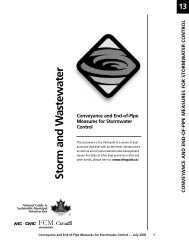The State of Canada's Cities and Communities 2012 - FCM
The State of Canada's Cities and Communities 2012 - FCM
The State of Canada's Cities and Communities 2012 - FCM
Create successful ePaper yourself
Turn your PDF publications into a flip-book with our unique Google optimized e-Paper software.
Chapter 5<br />
Page 4<br />
THE SQUEEZE ON HOMEOWNERSHIP<br />
<strong>The</strong> communities that make up the Quality <strong>of</strong><br />
Life Reporting System (QOLRS) represent over<br />
50% <strong>of</strong> Canada’s population. Following a decade<br />
<strong>of</strong> relatively modest growth in housing costs in<br />
the 1990s, the average price <strong>of</strong> buying a new<br />
home in Canada nearly doubled from $234,387<br />
to $454,154 between 2001 <strong>and</strong> 2010. This rise<br />
was reflected in QOLRS communities, where<br />
new home prices reached an average cost <strong>of</strong><br />
$505,044 in 2010. <strong>The</strong> average cost <strong>of</strong> a new<br />
home in Vancouver increased by over $900,000<br />
between 2001 <strong>and</strong> 2010. This was closely followed<br />
by a $700,000 increase in Toronto,<br />
$295,794 in Calgary <strong>and</strong> $275,044 in Regina.<br />
FIGURE 1. AVERAGE NEW HOUSING PRICES<br />
IN CANADA AND QOLRS COMMUNITIES, 2010<br />
Vancouver $1,443,790<br />
Toronto $1,154,422<br />
Metro Vancouver $891,434<br />
Surrey $667,144<br />
Capital Region District $622,862<br />
York $539,429<br />
Halton $536,006<br />
Calgary $519,849<br />
QOLRS $505,044<br />
Peel $503,631<br />
Edmonton $458,111<br />
Canada $454,154<br />
Ottawa $438,017<br />
Regina $433,989<br />
Hamilton $416,077<br />
Durham $412,787<br />
Saskatoon $397,054<br />
Niagara $370,996<br />
Winnipeg $370,606<br />
Waterloo $370,082<br />
Sudbury $352,966<br />
London $352,879<br />
St. John’s $342,596<br />
Halifax $340,168<br />
Montréal (CMM) $333,254<br />
Kingston $277,446<br />
Québec (CMQ) $257,048<br />
Gatineau $250,145<br />
SOURCE: CANADA MORTGAGE AND HOUSING CORPORATION,<br />
MARKET ABSORPTION SURVEY, 2010, SPECIAL ORDER FOR<br />
THE QOLRS<br />
Some QOLRS communities, however, experienced<br />
below-average increases; Kingston’s new<br />
home price grew by $107,086 over ten years <strong>and</strong><br />
Gatineau’s new home prices rose by $117,072.<br />
Average incomes have not kept pace with continually<br />
rising housing costs. Between 2006 <strong>and</strong><br />
2009, average income for the combination <strong>of</strong><br />
couple-families, lone-parent families, <strong>and</strong> single<br />
persons in QOLRS cities increased by 5.5%, while<br />
the average cost <strong>of</strong> homeownership rose by<br />
22%. 7 A healthy housing price-to-income ratio is<br />
generally considered to be four to one; the most<br />
recent figures available for the QOLRS show this<br />
ratio as greater than seven to one by 2010, an<br />
increase from four years earlier when the ratio<br />
was slightly greater than 6 to 1. 8<br />
Further, average incomes for 2009 were lower<br />
than in 2008 in both QOLRS communities <strong>and</strong><br />
the rest <strong>of</strong> Canada, reflecting the impact <strong>of</strong> the<br />
global economic recession. 9 Statistics Canada reports<br />
the largest gap between income <strong>and</strong> home<br />
ownership affordability is experienced by single<br />
persons <strong>and</strong> lone parent families.<br />
Rising housing costs are also cited as a major<br />
contributing factor responsible for Canadians’<br />
growing household debt. <strong>The</strong> Bank <strong>of</strong> Canada<br />
<strong>and</strong> the International Monetary Fund warn that<br />
Canadians’ 158% level <strong>of</strong> household debt is too<br />
high, with mortgages making up 68% <strong>of</strong> that<br />
debt. 10 <strong>The</strong> Government <strong>of</strong> Canada recently<br />
made regulatory changes to reduce mortgage<br />
amortization periods <strong>and</strong> protect households<br />
from further debt.<br />
7 Average income in the QOLRS rose from $68,332 in 2006 to $72,059 in 2009. Average new home cost in the QOLRS rose from $389,981 in 2006 to<br />
$502,865 in 2009. All income figures <strong>and</strong> housing costs are not adjusted for inflation.<br />
8 Average income in the QOLRS was $64,790 in 2005 <strong>and</strong> $72,059 in 2009, while the average cost <strong>of</strong> a new home was $389,981 in 2006 <strong>and</strong> $505,044<br />
in 2010. Housing to income to ratios rely on income reported from the previous year as an indicator <strong>of</strong> affordability.<br />
9 Source: Statistics Canada, Small Area <strong>and</strong> Administrative Data Division, 2008-2009. For more on the impact <strong>of</strong> the global recession on low-income<br />
Canadians see ‘Bearing the Brunt: How the 2008-2009 Recession Created Poverty for Canadian Families’ by the Ch<strong>and</strong>ra Pasma, May 2010. Citizens<br />
for Public Justice. Available at: http://www.cpj.ca/files/docs/Bearing_the_Brunt.pdf.<br />
10 Canada Mortgage <strong>and</strong> Housing Corporation (CMHC), ‘Household Indebtedness,’ Canadian Housing Observer 2011. Pg. 1. Available online at http://www.<br />
cmhc.ca/en/corp/about/cahoob/upload/Chapter_3_EN_dec16_w1 .pdf.

















